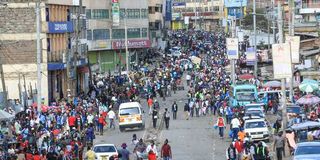Kenya now widely exposed to coronavirus

Travellers throng Muthurwa in Nairobi on July12, 2020 in a rush to travel upcountry. PHOTO | SILA KIPLAGAT | NATION MEDIA GROUP
What you need to know:
- In April, Kenya saw 328 positive cases from 19,108 samples, while in May, it recorded 1,615 positive cases out of 57,527 samples.
- From closure of airspaces, to social amenities, schools, restrictions in domestic movement and beaches, these countries locked down their citizens as they battled the virus.
A day after Kenya’s Covid-19 cases crossed the 10,000 mark, President Uhuru Kenyatta’s June dilemma over two competing rights is now unfolding, with numbers pointing to a possible health crisis.
While Kenyans are now free to move about and fend for their families, the virus, now at the community phase of infection, is spreading fast in towns and villages.
Since last Monday’s lifting of cessation of movement orders in Nairobi, Mombasa and Mandera, the country has recorded over 1,562 cases — its highest within a one-week period, with Friday topping at 474.
To put this into perspective, at the start of the pandemic in March, 1,419 samples were tested, with 78 turning positive.
90,000 TESTS
In April, Kenya saw 328 positive cases from 19,108 samples, while in May, it recorded 1,615 positive cases out of 57,527 samples.
As at the end of June, the country had done over 90,000 tests, with 4,049 of these turning positive. As the cases rise exponentially, will the lifting of these measures really hold?
At the 10,000 mark, countries that were hard hit by this pandemic — including the US, China, Italy, Spain and even the UK— were on the contrary tightening the restriction measures.
From closure of airspaces, to social amenities, schools, restrictions in domestic movement and beaches, these countries locked down their citizens as they battled the virus.

A conductor loading luggage on a waiting Matatu that operates between Kitui, Machakos and Nairobi on July 9, 2020 at Machakos Country Bus. PHOTO | DENNIS ONSONGO | NATION MEDIA GROUP
In June, President Kenyatta looked at the available worst-case scenario and the best options to contain the spread of the disease without affecting the economy irreversibly.
One, had Kenya not taken the stringent measures it did in March, the rate of infections would have peaked to 800,000 people by end of this month, with over 75,000 deaths by end of August.
With all necessary interventions in place, a 20 percent relaxation of the measures would lead to 200,000 infections and 30,000 deaths by December.
RELAXATION
A 40 percent relaxation would see the infections peak in November at 300,000 with over 40,000 deaths, while a 60 percent relaxation will see the pandemic peak in October with 450,000 infections, and 45,000 deaths.
Kenya set for itself three irreducible minimums, and the threshold it would allow for reopening. A month later, and having failed to meet these measures, it still reopened. Was this setting the country up for a crisis?
As it is, the country’s healthcare system is still not ready to take on a surge in infections, with the latest data on its capacity showing that the system will be overwhelmed.
By Friday, there were only 442 ICU beds and 437 ventilators in the country, with over 10,000 isolation beds, against the national target of 30,500 units, latest figures from the Council of Governors showed.
For counties like Vihiga, Elgeyo-Marakwet, Samburu, Tana River, Lamu and Embu, they did not even have a single ICU bed. At the same time, only 26 of the 47 counties had at least 300 beds in their isolation centres and ICU beds and ventilators.
In comparison, countries like South Africa, which is also implementing a phased reopening have around 2,000 ICU beds allocated to Covid-19 patients, with a further 13,000 field hospital beds, and 35,000 quarantine beds have been added to the total capacity, showing its state of preparedness.
For Kenya, the access to testing, isolation and quarantine across the country are not on the bare minimum, as there are places where these services remain non-existent.
MASS TESTING
In Rwanda, which has also opted to reopen, Kigali is currently piloting drive-through tests on major entries to its cities and bus stops, which it hopes will increase the number of people tested to understand the Covid-19 statistics.
On the contrary, Kenya quietly dropped the targeted mass testing.
South Africa has so far done almost 2 million tests, giving it an allowance to map the infections and what kind of interventions it needs.
Kenya’s tests at over 200,000 is still erratic and with a drop in the targeted mass testing as was done initially, and several counties lamenting that the testing samples has been hampered by a shortage of reagents, the country may not even be in a position to know the full extent of the infection rate.
The last threshold, which was having the capacity for surveillance and contact-tracing, is also non-existent. With the lifting of the restrictions on movement, contact-tracing has become an uphill task and has been dropped altogether.
CONTACT TRACING
Rwanda has once again shown how technology can be employed to enforce meticulous contact-tracing to beat community infections.
The Rwanda Utilities Regulatory Authority now relies on phone data profiles to trace people who had contacts with Covid-19 positive patients.
The authority is also able to use pings from mobile phone towers to trace these patients and avoid cases of them disappearing into the community, a problem Kenya grappled with, and gave up on, leading to more Covid-19 community exposure.
Given that most cases are asymptomatic since up to 65 of the country's population are people aged under 25 years, Kenya has been pushing for home-based care to leave the hospitals for critical care patient.
This initiative, though noble, will require discipline within the citizenry, something that is not guaranteed.




